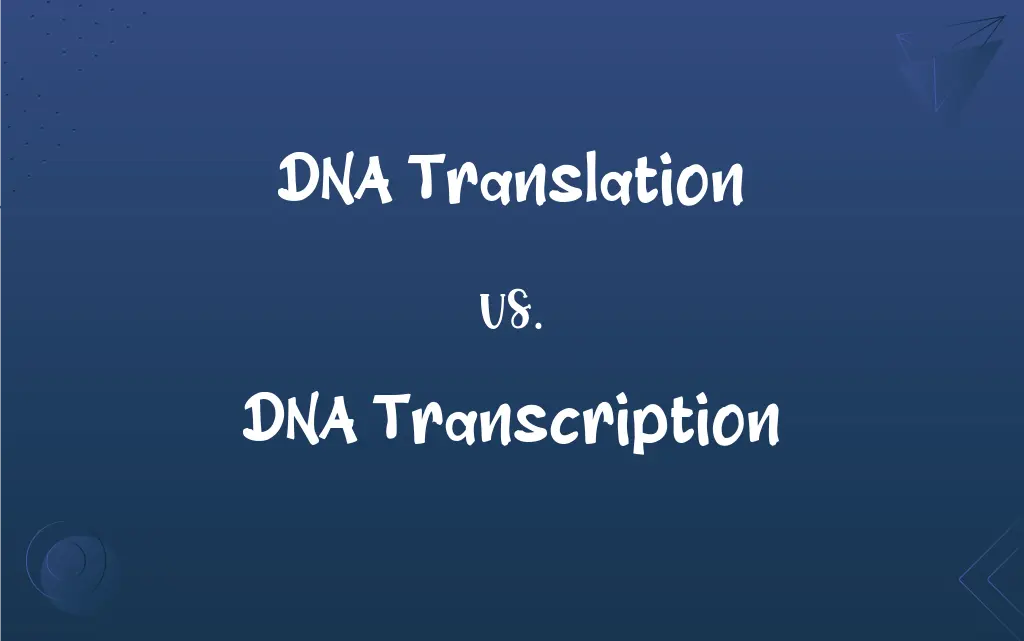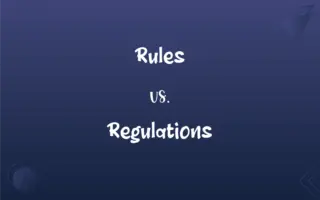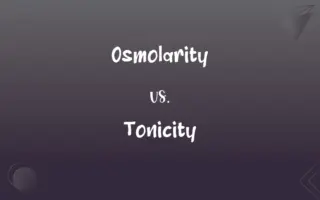DNA Translation vs. DNA Transcription: What's the Difference?
Edited by Aimie Carlson || By Harlon Moss || Updated on October 29, 2023
DNA translation is the process of synthesizing proteins from mRNA; DNA transcription is the process of synthesizing mRNA from DNA.

Key Differences
DNA translation is the process where the genetic information in messenger RNA (mRNA) is used to produce a specific protein. DNA transcription, on the other hand, is the process where a specific segment of DNA is copied into RNA by the enzyme RNA polymerase.
In DNA translation, the information in mRNA is read by ribosomes, which then use this information to build a protein. DNA transcription involves the synthesis of RNA molecules that are complementary to one strand of DNA.
DNA translation occurs in the cytoplasm of a cell, where the ribosomes are located. DNA transcription occurs in the nucleus, where the DNA is housed.
The products of DNA translation are proteins, which are necessary for many cellular functions. The products of DNA transcription are RNA molecules, which are used in the process of protein synthesis.
Comparison Chart
Location
Cytoplasm
Nucleus
ADVERTISEMENT
Process
Synthesizing proteins
Synthesizing RNA
Machinery used
Ribosomes
RNA polymerase
Product
Proteins
RNA molecules
Initial Material
MRNA
DNA
DNA Translation and DNA Transcription Definitions
DNA Translation
DNA translation results in the production of proteins.
Proteins are the final product of DNA translation.
ADVERTISEMENT
DNA Transcription
DNA transcription requires DNA as the initial material.
DNA provides the genetic information for RNA synthesis.
DNA Translation
DNA translation is the process of synthesizing proteins from mRNA.
DNA translation occurs in the cytoplasm of a cell.
DNA Transcription
DNA transcription is essential for gene expression.
Gene expression relies on RNA produced during DNA transcription.
DNA Translation
DNA translation involves the use of ribosomes.
Ribosomes read the information in mRNA during DNA translation.
DNA Transcription
DNA transcription involves the enzyme RNA polymerase.
RNA polymerase synthesizes RNA molecules during DNA transcription.
DNA Translation
DNA translation requires mRNA as the initial material.
MRNA carries the genetic information needed for DNA translation.
DNA Transcription
DNA transcription results in the production of RNA molecules.
RNA molecules are used in the process of protein synthesis.
DNA Translation
DNA translation is essential for cellular functions.
Many cellular processes rely on proteins produced during DNA translation.
DNA Transcription
DNA transcription is the process of synthesizing RNA from DNA.
DNA transcription occurs in the nucleus of a cell.
FAQs
What is DNA translation?
The process of synthesizing proteins from mRNA.
What is involved in DNA translation?
Ribosomes and mRNA.
Does DNA transcription produce proteins?
No, it produces RNA molecules.
What is the product of DNA translation?
Proteins.
Why is DNA transcription essential?
For gene expression.
What is the initial material for DNA translation?
mRNA.
Why is DNA translation essential?
For cellular functions and processes.
Is RNA polymerase involved in DNA translation?
No, it is involved in DNA transcription.
Can DNA transcription occur without DNA?
No, DNA is necessary for DNA transcription.
Where does DNA transcription occur?
In the nucleus of a cell.
What is involved in DNA transcription?
RNA polymerase and DNA.
What is the product of DNA transcription?
RNA molecules.
What is the initial material for DNA transcription?
DNA.
Does DNA translation occur in the nucleus?
No, it occurs in the cytoplasm.
Does DNA transcription occur in the cytoplasm?
No, it occurs in the nucleus.
What is DNA transcription?
The process of synthesizing RNA from DNA.
Where does DNA translation occur?
In the cytoplasm of a cell.
Can DNA translation occur without mRNA?
No, mRNA is necessary for DNA translation.
Are ribosomes involved in DNA transcription?
No, they are involved in DNA translation.
Does DNA translation produce RNA molecules?
No, it produces proteins.
About Author
Written by
Harlon MossHarlon is a seasoned quality moderator and accomplished content writer for Difference Wiki. An alumnus of the prestigious University of California, he earned his degree in Computer Science. Leveraging his academic background, Harlon brings a meticulous and informed perspective to his work, ensuring content accuracy and excellence.
Edited by
Aimie CarlsonAimie Carlson, holding a master's degree in English literature, is a fervent English language enthusiast. She lends her writing talents to Difference Wiki, a prominent website that specializes in comparisons, offering readers insightful analyses that both captivate and inform.































































